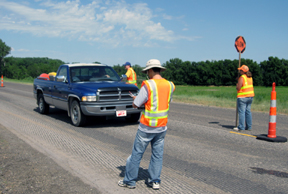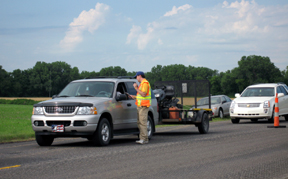Research Under Way to Reduce Work Zone Crashes

Engineers at the University of Kansas are researching ways to improve safety at highway work zones in the state.
Highway work zones constitute a major safety concern for government agencies, the legislature, the highway construction industry, and the traveling public. Based on the Federal Highway Administration's statistics data, nationwide, 1,068 people were killed and about 40,000 people were injured as a result of motor vehicle crashes in work zones in 2004. The direct cost of highway work zone crashes, estimated based on the crash data from 1995 to 1997, is as high as $6.2 billion a year. Today the majority of highway funds are being used on road and bridge preservation including resurfacing, restoration, rehabilitation, and reconstruction. As a result the traveling public is encountering more highway work zones and the trend will continue in the future.
In an effort to provide a safe driving environment for motorists, the Kansas Department of Transportation has awarded three research projects to address various issues of work zone safety to Yong Bai, an assistant professor in the Department of Civil, Environmental, and Architectural Engineering at the University of Kansas since 2004.

One project investigates the effectiveness of an innovative warning sign that is deployed by using a vehicle's emergency flashers in work zones utilizing a pilot car and flagging operation. The effectiveness of the warning sign is measured using two methods. Researchers will compare changes in the speed of vehicle entering the work zone's pilot-car region with and without the warning sign. If speeds of vehicles decrease when emergency flashers are turned on, then, a conclusion can be reached that the warning sign has a positive impact on drivers' behaviors. A slow speed is more likely to reduce the probability of having a crash or the severity of a crash. Bai and his research team also will survey the drivers who simply pass through the work zones with or without this particular warning sign to determine if the signal has any effect on their driving behavior.

Bai and his research team members, Brandon T. Harvey, an undergraduate research assistant, and doctoral student Yingfeng Li, conducted the first field experiment in June to test the effectiveness of the warning sign on a U.S. Highway 36 work zone near Washington, Kan. Two speed detection sensors used in the experiment were furnished by the KU Transportation Research Institute (TRI). Researchers set up the speed detection system at the project site and ask the first motorist into the zone to turn on the vehicle's emergency flashers. The subsequent driver to arrive at the work zone pilot-car area is then surveyed by the research team to learn more about what the subsequent driver experienced upon entering the work zone.
More field experiments are scheduled in July. The research project is expected to complete by the end of 2007. If found to be an effective measure, results of this research project could save lives and millions of dollars.